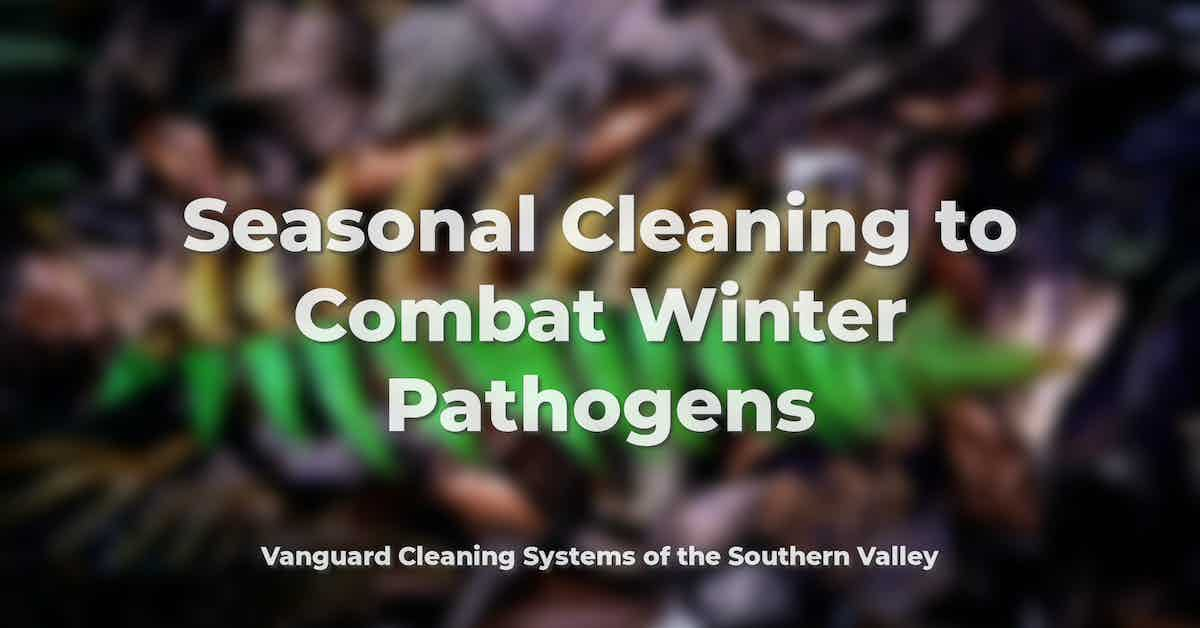Winter is rapidly approaching, so it's time to start focusing on enhanced environmental cleaning practices to prevent the transmission of seasonal germs.

The Importance of Environmental Cleaning for Seasonal Illness Prevention
The intent behind cleaning for health practices is to remove unwanted soil and other microbes from a built environment, resulting in improved occupant health and safety.
Outside of healthcare facilities, environmental cleaning is rarely more critical to occupant health than during the long months of the annual cold and flu season.
Cold weather, variations in humidity, and shorter days combine to increase the time pathogens can remain airborne and infectious--significantly increasing transmissibility.
Additionally, time spent indoors with others increases during the same period, furthering the probability of contacting a contagious occupant or contaminated surface.
The Economic Burden of Seasonal Illness
Generally, the economic burden of seasonal illness is divided between influenza or influenza-like illnesses (ILI) and non-influenza-like illnesses--each of which results in annual healthcare and social costs approaching $40B.
According to a 2003 study published by the Jama Network regarding the yearly costs attributed to non-influenza respiratory infections;
[...] approximately 500 million non–influenza-related [Viral Respiratory Tract Infection] VRTI episodes occur per year.
Similarly, if the treatment patterns reported by the respondents are extended to the population, the total economic impact of non–influenza-related VRTI approaches $40 billion annually (direct costs, $17 billion per year; and indirect costs, $22.5 billion per year).
The Economic Burden of Non–Influenza-Related Viral Respiratory Tract Infection in the United States
In regards to the costs attributed to annual influenza infections;
The estimated average annual total economic burden of influenza to the healthcare system and society was $11.2 billion ($6.3-$25.3 billion).
Direct medical costs were estimated to be $3.2 billion ($1.5-$11.7 billion) and indirect costs $8.0 billion ($4.8-$13.6 billion).
These total costs were based on the estimated average numbers of (1) ill-non medically attended patients (21.6 million), (2) office-based outpatient visits (3.7 million), (3) emergency department visit (0.65 million) (4) hospitalizations (247.0 thousand), (5) deaths (36.3 thousand) and (6) days of productivity lost (20.1 million).
How Seasonal Germs Spread
Winter germs are typically spread by one of three methods:
- Airborne--inhaling or ingesting contaminated droplets expelled from an infected person either through coughing, sneezing, or occasionally, breathing or talking.
- Direct contact--the virus is transmitted from one person to another through direct contact (shaking hands) and then either ingested or passed into the body through the eyes, ears, or nose, and;
- Indirect contact--the virus is passed to a new host from a contaminated surface and then ingested or passed into the body through the eyes, ears, or nose.
According to the U.S. Centers for Disease Control and Prevention (CDC), seasonal influenza, like SARS-CoV-2, spreads primarily through the air as contaminated droplets that can fall onto facility surfaces and remain infectious for several hours without intervention.
People with flu can spread it to others up to about 6 feet away.
Most experts think that flu viruses spread mainly by droplets made when people with flu cough, sneeze or talk.
These droplets can land in the mouths or noses of people who are nearby or possibly be inhaled into the lungs.
Less often, a person might get flu by touching a surface or object that has flu virus on it and then touching their own mouth, nose, or possibly their eyes.
Other seasonal infections that quickly spread through contact with contaminated surfaces include:
- Strep throat.
- Norovirus
- Bronchitis, and;
- Pneumonia.
Intervention Methods to Prevent the Spread of Seasonal Illness
A combination of enhanced environmental cleaning procedures, strategic disinfection practices, and indoor air quality enhancement methods will disrupt the transmission of infection indoors.
- Identify and disinfect high contact surfaces at the start and end of each day and between uses during outbreaks.
- Sweep, vacuum, and mop all floors and mats at the end of each day, increasing spot-cleaning rates in high-traffic areas during outbreaks.
- Wet clean all horizontal surfaces in occupied facility spaces at the end of each day, increasing cleaning rates during outbreaks.
- Where possible, upgrade HVAC HEPA filters to a minimum MERV-13 rating.
- Open windows if it's not too cold or causing occupant discomfort, particularly in restrooms and while cleaning and disinfecting.
- Disinfect high-risk facility areas, such as restrooms and dining areas, at least once daily, increasing rates as needed to adjust for occupancy or local outbreaks.
- Install portable commercial-grade air cleaners in occupied facility spaces where HVAC upgrades or open doors and windows are not possible, and;
- Use Safer Choice or Green Seal-certified products to reduce the introduction of VOCs into the air and toxic chemicals into the natural environment.
Takeaway
Implementing a simple three-step process will significantly reduce the transmission and economic burden of seasonal illnesses.
- Clean every day with an EPA-registered commercial-grade detergent applied with microfiber.
- Disinfect high-touch surfaces after each use, and;
- Increase the airflow rate through the facility, either naturally or with an HVAC system.
Onboarding the requisite material resources and skilled labor to ensure high-level outcomes may prove cost-prohibitive for many organizations.
Outsourcing is a proven method for onboarding highly in-demand cleaning and disinfection services and experience for a fraction of the price of maintaining a similar service in-house.
If you would like more information regarding the effectiveness of high-performance infection prevention and control measures, or if you would like to schedule a free, no-obligation on-site assessment of your facility's custodial needs, contact us today for a free quote!
In Bakersfield, CA, call (661) 437-3253
In Fresno, CA, call (559) 206-1059
In Valencia, CA, or Santa Clarita, CA, call (661) 437-3253
In Palmdale, CA, or Lancaster, CA, call (661) 371-4756

